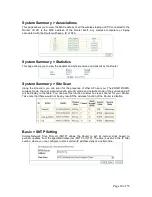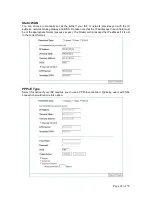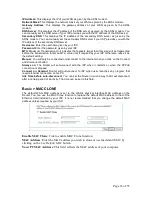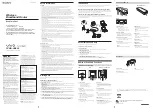
Page 8 of 55
5
BASIC IP NETWORKING
Internet Protocol (IP)
IP stands for Internet Protocol. In an IP network, every device has a unique IP Address (For
example: 192.168.1.35) to identify itself. There are two ways of assigning an IP address to a PC
or Router: Static and Automatic (DHCP). Static IP addresses are keyed-in manually, while
Dynamic IPs are distributed by a DHCP Server.
Ports
Every packet of traffic is identified by its Source and Destination Addresses, which would ensure
that the packet arrives at the correct destination. A Port Number is also embedded in each
packet; to identify which software application that generated and uses that packet. Therefore, if
the Router blocks a certain port number, it denies the particular software from using the
connection.
Static IP Address
Static IP addressing ensures that the device will always have the same IP address. Static
addressing is commonly used for your servers.
Dynamic IP Address
A dynamic IP address is one that is automatically assigned to a PC. These IP addresses are
“dynamic” because they are only temporarily leased to the PC when it connects to the network.
This is the most convenient and common way of managing IP addresses in a network. The
Server that manages this pool of IP addresses is called the DHCP Server. The product has a
DHCP Server built-in to simplify the network management.
DHCP (Dynamic Host Configuration Protocol)
The PC obtaining an IP address from the Server is called the DHCP Client. If there is already a
DHCP Server running on your network, you must disable one of the two DHCP servers. Running
more than one DHCP server together will cause network problems!
What is a Router?
A router is a network device that connects two networks together, to let them communicate. All
the PCs in your home or office would be considered to be in one network: the Local Area Network
(LAN). The Internet (including the ADSL modem) is considered to be another network: the Wide
Area Network (WAN). The Router serves 2 purposes:
Connect all the PCs in the LAN together, allowing them to communicate with one
another. (File sharing, Printer sharing etc.)
Connect all the PCs in the LAN to the Internet, allowing them to simultaneously surf the
web and access e-mails.
The Router is connected to 2 networks at the same time. Therefore, it has two IP addresses: one
for the LAN, and one for the WAN. The Router’s LAN IP address can be configured, but it is best
to
use
the
default
settings.
The
WAN
port
is
a
DHCP
client
by
default.









































